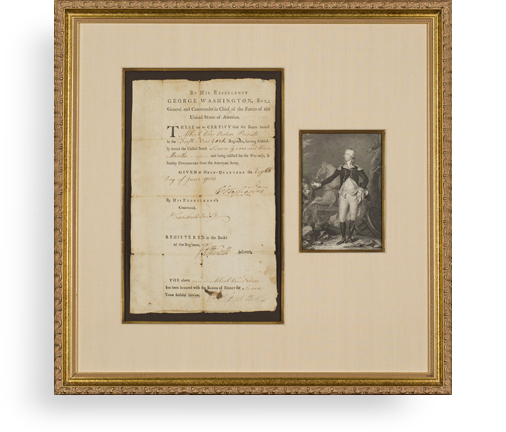President Abraham Lincoln Promotes the Chief of Ordnance for Cairo, Ill, Who Helped Supply Union Forces During the Siege of Fort Donelson


The appointee was present at the surrender of Lee and became one of the nation's most celebrated ordnance officers, traveling the world for the US
- Currency:
- USD
- GBP
- JPY
- EUR
- CNY
As 1862 opened, the war was not going well for the Union. In the east, Bull Run had been a disaster and led to the shake-up of command, with no results yet to show for it. In the west, the loss at Wilson’s Creek gave the Confederates the upper hand. The Federal...
As 1862 opened, the war was not going well for the Union. In the east, Bull Run had been a disaster and led to the shake-up of command, with no results yet to show for it. In the west, the loss at Wilson’s Creek gave the Confederates the upper hand. The Federal armies in the west then turned their attention to implementation of the Anaconda Plan – to cut the Confederacy in half by securing the Mississippi River from St. Louis all the way to the Gulf of Mexico, and clearing a maritime invasion route into the heart of the Confederacy by taking the Tennessee and Cumberland Rivers, which lay just to the east of the Mississippi. If successful, these maneuvers would cut Texas, Arkansas and Louisiana off from the main body of the South, hold Kentucky and Missouri firmly in the Union, and make it difficult for Tennessee to cooperate with her sister Confederate states. The first moves would be to take and hold commanding locations north on the Tennessee and Cumberland rivers, and command of the operation was given to Brig. Gen. Ulysses S. Grant, an obscure and largely unproven officer.
On February 6, 1862, Fort Henry, commanding the Tennessee River, was captured by Grant’s forces. It had a poor defensive position, and was reduced mainly by the bombardment of gunboats on the river. Nonetheless, its fall opened the Tennessee River to Union gunboats and shipping past the Alabama border, and provided a real victory for Union arms. Grant next focused his attention on Fort Donelson, eleven miles away on the more strategically important Cumberland River. This fort had a much stronger physical position, and the Confederates had placed some 20,000 men and a number of senior commanders on site to engage in its defense. They were not about to concede the fort, and they were ready and waiting for Grant. Grant arrived at Fort Donelson late on February 12 and on the 13th established his headquarters near the left side of the front of the line. That day was spent in battle preparation, with a few small probing attacks being carried out against the Confederate defenses.
Grant’s headquarters was at Cairo, Ill, where the head of Ordnance was Stephen Lyford. Grant arrived at Fort Donelson late on February 12 and on the 13th established his headquarters near the left side of the front of the line. That day was spent in battle preparation, with a few small probing attacks being carried out against the Confederate defenses.
The battle was severe, with nearly 1,000 soldiers on both sides killed and about 3,000 wounded. When Simon Buckner, the Confederate commander, asked for surrender terms, Grant famously replied, “No terms except unconditional and immediate surrender can be accepted,“ adding “I propose to move immediately upon your works.” Buckner surrendered his command of about 15,000 men; this was the first of three Confederate armies that Grant captured during the war.
The capture of Fort Donelson gave the North control of the Cumberland River, which provided the road that opened the Deep South to Union invasion. It boosted morale in the North, which now saw that the war could result in great victories and not just defeats. It gave President Lincoln the fighting general he was looking for, and it made Grant’s career in the process; he was soon promoted to major general of volunteers.
Stephen C. Lyford had a long and distinguished career. He served from May to August, 1861, in the defenses of Washington, D. C., and in the Manassas Campaign, participating in the Battle of Bull Run, July 21, 1861. He was Aide-de‑Camp to Brig. General McDowell, in the defenses of Washington, D. C., August to October, 1861 and Asst. Ordnance Officer at St. Louis Arsenal, Mo., November 2, 1861, to February 1, 1862; in command of the Cairo Ordnance Depot, Ill., February to May, 1862, being detached to the Cumberland River, and was present at the Surrender of Ft. Donelson. He was part of Gen. Halleck’s Mississippi Campaign, May to July, 1862, being engaged in the Siege of Corinth, May, 1862 and was Chief of Ordnance, for Department of the Tennessee, July 11, 1862, to September 6, 1863, and fought in the Battle of Corinth. He would go on to teach at West Point and also serve as aide-de-camp for Gen. Halleck and as representative of the US to Japan to bring back information and technology relevant for American ordnance.
Document signed, with engravings of flags and weapons, Washington, March 4, 1862, Naming Lyford a “Second Lieutenant in the Ordnance Department.”

Frame, Display, Preserve
Each frame is custom constructed, using only proper museum archival materials. This includes:The finest frames, tailored to match the document you have chosen. These can period style, antiqued, gilded, wood, etc. Fabric mats, including silk and satin, as well as museum mat board with hand painted bevels. Attachment of the document to the matting to ensure its protection. This "hinging" is done according to archival standards. Protective "glass," or Tru Vue Optium Acrylic glazing, which is shatter resistant, 99% UV protective, and anti-reflective. You benefit from our decades of experience in designing and creating beautiful, compelling, and protective framed historical documents.
Learn more about our Framing Services










































































































